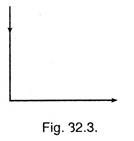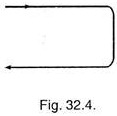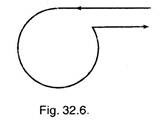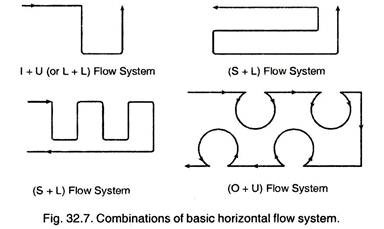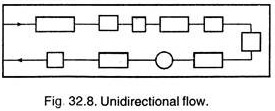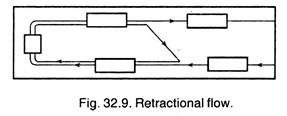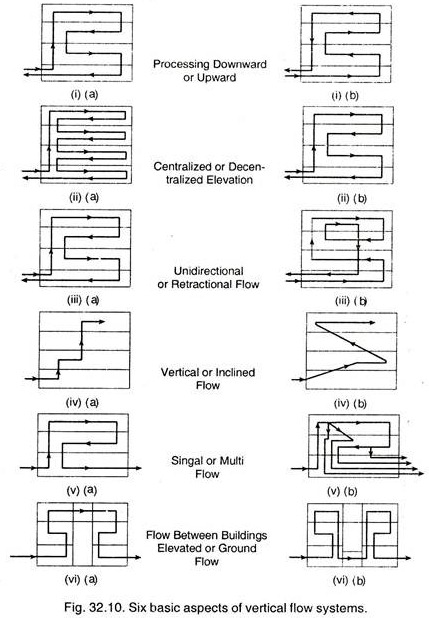After reading this article you will learn about:- 1. Meaning of Flow Pattern 2. Factors Governing Flow Pattern 3. Types.
Meaning of Flow Pattern:
“Flow Pattern” means the system to be adopted, for the movement of raw materials, from the beginning and up to the end of manufacturing. The overall-objective of the ‘Flow Pattern’ is to plan for the economical movement of the raw materials throughout the plant.
The Flow Pattern affects the following:
(i) Materials handling cost.
ADVERTISEMENTS:
(ii) Amount of work-in-process.
(iii) Capital and space tied up by work-in-process.
(iv) Length of total production time.
(v) The rate of the performance and coordination of operations.
ADVERTISEMENTS:
(vi) Amount of physical and mental strain on the operators.
(vii) Supervision and control mechanisms.
Quite often a plant layout design starts with the flow system around which services and other facilities are added and building design are modified accordingly but sometimes the flow must be adopted to suit existing buildings.
Factors Governing Flow Pattern:
(i) External transport facilities.
ADVERTISEMENTS:
(ii) Number of products to be handled.
(iii) Number of operations on each product.
(iv) Number of units to be processed.
(v) Number of sub-assemblies made up ahead of assembly line.
ADVERTISEMENTS:
(vi) Size and shape of available land.
(vii) Necessary flow between work areas.
Types of Flow Pattern:
The flow patterns can be classified into horizontal and vertical. The horizontal flow system is adopted on a shop floor while vertical flow is adopted where material has to move in a multi-storey building.
1. Horizontal Flow Lines:
ADVERTISEMENTS:
There are five basic types of horizontal flow line:
(i) I-Flow or Line Flow.
(ii) L-Flow.
(iii) U-Flow.
ADVERTISEMENTS:
(iv) S-Flow.
(v) O-Flow.
(i) I-Flow or Line Flow:
It is the simplest form of flow. In this, materials are fed at one end and components leave the line at the other end. This type is economical in space and convenient in I-shaped buildings. I-Flow is preferred for building automobile Industries (Fig. 32.2).
(ii) L-Flow:
It is similar to the I-Flow and is used where I-line cannot be accommodated in the available space (Fig. 32.3).
(iii) U-Flow:
In this, both feeding and output take place at the same end i.e., it allows both receiving and despatching of goods to be done on one side. In comparison to I or L-Flow, this method is easier for supervision. This type of flow can be adopted in the manufacture of Electric Motor Industry etc. (Fig. 32.4).
(iv) S-Flow:
ADVERTISEMENTS:
If the production line is so long that zig-zagging on the plant floor is necessary, than S-Flow is adopted. This type provides efficient utilization of space and is compact enough to allow effective supervision [Fig. 32.5 (a) and (b)].
(v) O-Flow:
This type is used where processes or operations are performed on a rotary table or a rotary handling system. The components are moved from one working station to the other and when they leave the O-line, a complete set of processes or operations have been performed.
The components are inspected before they are moved on to a second line for an additional series of processes or operations or to an assembly line. O-Flow can be adopted by industries manufacturing electric bulbs (Fig. 32.6).
These above mentioned basic flow lines are mostly used by industries in various combinations. Examples of combinations of basic horizontal flow systems are shown below in Fig. 32.7.
Unidirectional and Retractional Flow:
(a) Unidirectional Flow:
The flow is said to be unidirectional when the material is passed from one work station to another without having to pass along the same path (Fig. 32.8). The flow methods explained above are all unidirectional type of flow.
(b) Retractional Flow:
ADVERTISEMENTS:
In this, the flow is repeated i.e., two or more non-consecutive operations are performed on the same machine. The aspect of flow is decided by consideration of machine utilization.
In this flow, the available machine time is fully utilized but schedules have to allow for repeated machine setting and for the fact that intermittent localized halts occur in the production line i.e., each time a machine is switched over from one operation setting to another. This flow is also known as Repeated flow (Fig. 32.9).
2. Vertical Flow Lines:
This type of flow is for multi-storey buildings. In order to have the materials handling systems and control mechanisms to operate effectively, following six basic aspects of vertical flow systems are in use (Fig. 32.10).
(i) Processing downward or upward.
(ii) Centralized or Decentalized elevation.
(iii) Unidirectional or Retractional flow.
(iv) Vertical or Inclined flow.
(v) Single or Multi-flow.
(vi) Flow between buildings.
ADVERTISEMENTS:
(i) Processing Downwards or Upwards:
In downward processing, the materials are fed from the top floor and in upward processing the materials are fed from the bottom floor while the finished product is received at the top floor.
In processing downward much gravity handling system such as roller lines, chutes, pipes, buckets, hand operated lifts etc. can be used. These are economical in installation, operation, maintenance etc.
(ii) Centralized or Decentralized Elevation:
In a centralized elevation all the material handling devices are installed at one central place of the building. Therefore, this system is economical in supervision and maintenance. It sometimes reduces installation cost also. This method is usually employed when the flow on each floor is a U-flow.
A decentralized elevation method is more costly in installation, maintenance and space, but by this method handling on each floor can be greatly reduced and more flexibility in design of the flow lines is possible.
(iii) Unidirectional or Retractional Flow:
In retractional type of flow, material has to come back on the floor which had already passed previously. This is done purposely to achieve better utilisation of available space and machines.
(iv) Vertical or Inclined Flow:
This type of flow is more economical and carried on with material handling devices such as elevators, chutes, buckets etc. In addition, inclined flow may also be carried out by conveyor belts as used in coal handling plants and chain system to move boiler grates etc. and similar other tasks.
(v) Single or Multi-flow:
In a single flow, there is only one flow line of materials while in multi-flow, there will be several flow lines and all these feed one assembly line.
(vi) Flow between Buildings:
When one production line is executed in several adjacent buildings, the flow of goods may be achieved either on an elevated floor or a ground floor. Ground floor is cheaper but requires more handling than an elevated floor. Elevated flow frees the ground for traffic and storage purposes.

